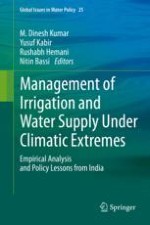2021 | OriginalPaper | Buchkapitel
2. Climate Variability and Its Implications for Water Management in India
verfasst von : Vedantam Niranjan, M. Dinesh Kumar, Nitin Bassi
Erschienen in: Management of Irrigation and Water Supply Under Climatic Extremes
Aktivieren Sie unsere intelligente Suche, um passende Fachinhalte oder Patente zu finden.
Wählen Sie Textabschnitte aus um mit Künstlicher Intelligenz passenden Patente zu finden. powered by
Markieren Sie Textabschnitte, um KI-gestützt weitere passende Inhalte zu finden. powered by
